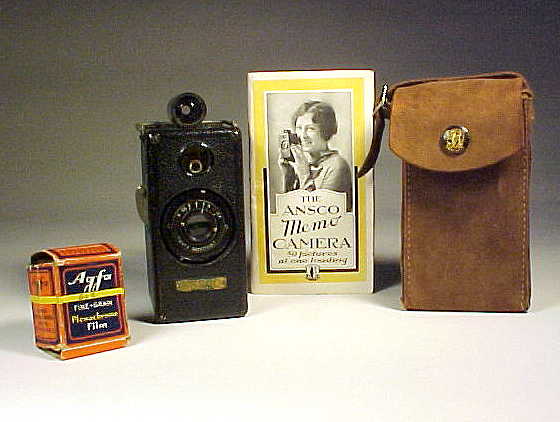
Ansco Memo Camera, Instructions, Case and Film

The Ansco Memo camera is a wood-bodied 35mm half-frame camera dating to the late 1920s. It was not the first American camera made for 35mm film, but it is the first American 35mm to sell in quantity. Earlier American 35mm cameras are much rarer. They were produced and sold in small numbers.
This is the first Ansco camera to carry the Memo name. Later, Ansco and Agfa-Ansco used the Memo name on cameras with different designs.
The Ansco Memo was introduced around January, 1927, almost two years after Ernst Leitz introduced the Leica A. The Leica camera produced a full-frame 35mm image. The Ansco Memo is a half-frame 35mm camera. Given that these early 35mm still cameras were shooting cine film, with its fairly coarse grain, the Leica with its larger image size unquestionably produced a better quality photograph than the Ansco Memo.
In A New Look at the Old 35, by Thurman (Jack) Naylor, Mr. Naylor comments that the first Memo instruction book dates to November, 1926. He also wrote that the first advertisement for the Memo camera appeared in The Camera in January, 1927. He goes on to say that this information apparently conflicts with a letter dated September 2, 1970, from GAF Corporation stating "The first Memo (upright single frame design of wood construction) was introduced in 1924". Mr. Naylor speculates that the letter's author may have intended to say "developed" rather than "introduced". Indeed, if the earliest known Memo manual was first printed in November, 1926, then this conclusion makes perfect sense.
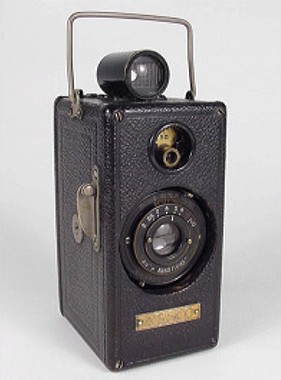
Ansco Memo cameras were produced in numerous configurations. Variations included models with an f/6.3 lens, f/3.5 lens, focusing and non-focusing lenses, plain uncovered wood bodies, leather covered bodies, and a wood olive-drab Boy Scout model. There were models that focused to three feet, and others that focused to two feet. Lenses were provided by Wollensak, Bausch & Lomb, Ilex, Agfa and possibly other makers. The lens on this example is an Afga Anastigmat.
This view of the Memo shows the foldable wire handle and tubular optical viewfinder on the camera top. The viewfinder image is large, contrasty and clear. Unlike some simple viewfinders, the Memo finder gives a good indication of the field of view.
On the side of the body is the shutter release lever. As this is a later version camera, the shutter release is protected against being accidentally bumped by a guard plate. Earlier Memos did not have a shutter release guard.
The round cutout on the front of the body above the lens is the frame counter window. The frame counter is a large round brass plate with easy to read markings. The counter is numbered to 50, and is the manual reset type. To reset the counter for a new roll of film, simply place your thumb on the round knob, press in and rotate.
The shutter on this example is a Wollensak Betax No. 4, with speeds from 1/5 to 1/100 second, plus time and bulb. The shutter is self-cocking. It is not necessary to arm and release the shutter in two separate operations. Just pressing down on the shutter release performs both tasks.
The lens is an f/3.5 Agfa Anastigmat, with stops to f/16 and front-cell focus from 2 to 100 feet. It is interesting that the greatest marked focusing distance is not infinity, but 100 feet.
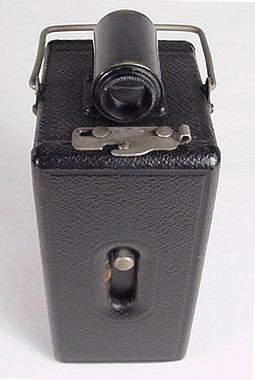
The back latch can be seen on the top edge in front of the viewfinder eyepiece. The back is fully removable for loading. The post extending from the slot in the camera back is the film advance trigger. Film is advanced by pressing down on this post.
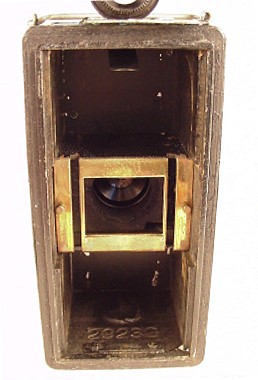
This is a view of the Memo film chamber. This camera has a simple and elegant means of film transport. A cassette of fresh film is inserted at the top, and an empty receiving cassette goes in the bottom. To load the camera, a short length of film is drawn across the center brass aperture and inserted into the lower cassette. Then the back is replaced, and the trigger is advanced three times. Now the camera is ready for use.
You may now be aware that the Memo has no film wind knobs, no spools, and quite unusual for a 35mm camera, no film sprocket. The Memo film transport was patterned after cine camera claw designs, in contrast to the spool and sprocket transport found in most 35mm still cameras. This design certainly reduced the camera's complexity and cost of manufacture. For the user, pulling down on the film advance was akin to the action of a modern wind-lever, an alternative to the ubiquitous wind-knob.
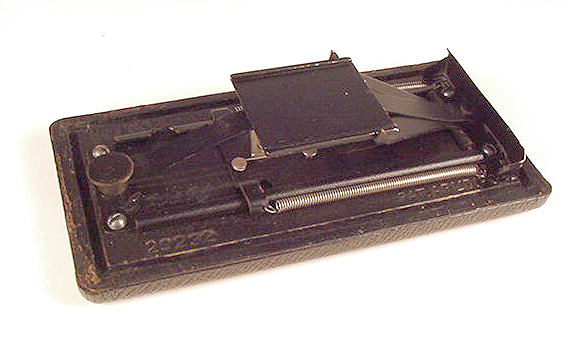
This is the inside of the removable Memo back. The raised square is the film pressure plate. It is suspended by two leaf springs. Two strips of metal extend up to the right and left edges of the pressure plate. The tips of these strips are pointed. These are the claws that engage the film's sprocket holes to pull film from the upper to lower cassette. These strips are attached at their other end to the film advance trigger.
A patent for the Ansco Memo camera, in particular, the Memo film advance, can be found on the Patents page.
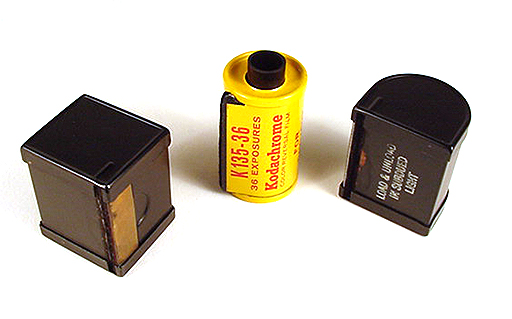
The standard 35mm cassette in use today was introduced by Eastman Kodak in 1934. Prior to this date, manufacturers of 35mm cameras provided proprietary cassettes for their cameras. Shown are two styles of Memo cassettes, one square and one rounded. The square cassette is an earlier style. Both cassettes fit this Memo camera and were found with it. A modern 35mm cassette, center, is shown for comparison.
A patent for the Ansco 35mm film cassette can be found on the Patents page.
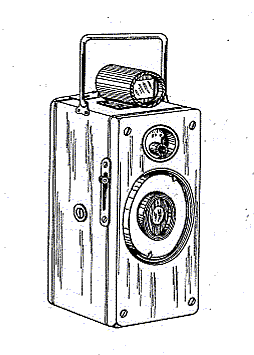
The drawing above is from Carl Bornmann's design patent, number D74,211, titled Camera Casing. The patent was filed on January 22, 1927 and granted January 10, 1928. This design concept came to life as the distinctive looking Ansco Memo camera.
If you have an interest in very early 35mm still cameras, find a copy of A New Look at the Old 35, by Thurman (Jack) Naylor. You may have to search a bit, as it was published in 1980, but it would be well worth the effort.

|
Page created June 19, 2001; updated December 20, 2020
|